
The Isle of Portland is a tied island, 6 kilometres (4 mi) long by 2.7 kilometres (1.7 mi) wide, in the English Channel. The southern tip, Portland Bill lies 8 kilometres (5 mi) south of the resort of Weymouth, forming the southernmost point of the county of Dorset, England. A barrier beach called Chesil Beach joins Portland with mainland England. The A354 road passes down the Portland end of the beach and then over the Fleet Lagoon by bridge to the mainland. The population of Portland is 13,417.
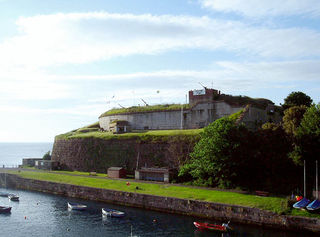
Nothe Fort is a fort in Weymouth, Dorset, England, situated at the end of the Nothe Peninsula, which juts eastwards from the town of Weymouth, and Weymouth Harbour, into the sea to the north of the ex-military Portland Harbour. The fort is located next to Nothe Gardens.

Sandsfoot Castle, also known historically as Weymouth Castle, is an artillery fort constructed by Henry VIII near Weymouth, Dorset. It formed part of the King's Device programme to protect against invasion from France and the Holy Roman Empire, and defended the Weymouth Bay anchorage. The stone castle had an octagonal gun platform, linked to a residential blockhouse, and was completed by 1542 at a cost of £3,887. Earthwork defences were built around the landward side of the castle, probably in 1623. Sandsfoot saw service during the English Civil War, when it was held by Parliament and Royalists in turn during the conflict. It survived the interregnum but, following Charles II's restoration to the throne, the fortress was withdrawn from military use in 1665.

Castletown is a small village in Underhill on the Isle of Portland in Dorset. It is located close to Fortuneswell, on the shores of Portland Harbour, and includes a sandy beach, as well as one of Portland's notable highlights; Portland Castle, while the Weymouth and Portland National Sailing Academy is also located nearby.

The Weymouth Pavilion, formerly the Ritz, is a theatre in Weymouth, Dorset. The complex contains a 988-seat theatre, 600 (maximum) capacity ballroom known as the Ocean Room, the Piano Bar restaurant, Ritz Cafe and other function and meeting rooms.
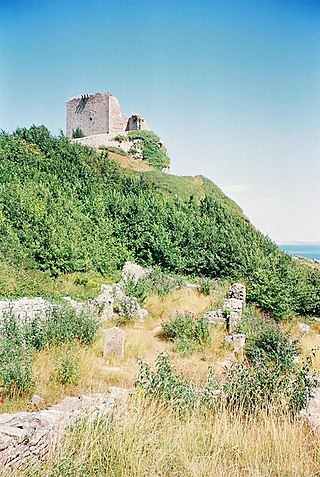
Rufus Castle, also known as Bow and Arrow Castle, is a partially ruined castle overlooking Church Ope Cove on Portland, England. Its name derives from King William II, known as William Rufus, for whom the original castle was built.
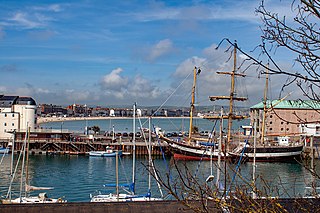
Weymouth is a seaside town in Dorset, on the English Channel coast of England. Situated on a sheltered bay at the mouth of the River Wey, 11 kilometres (7 mi) south of the county town of Dorchester, Weymouth had a population of 53,427 in 2021. It is the third largest settlement in Dorset after Bournemouth and Poole.
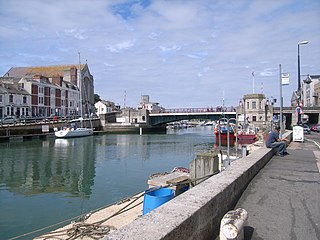
Weymouth Harbour is a picturesque harbour at the seaside town of Weymouth in Dorset, southern England,. It has a 17th-century waterfront.
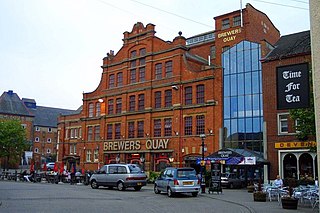
Brewers Quay is a converted Victorian brewery on the south side of Hope Square near the Old Harbour in Weymouth, Dorset, southern England. Much of the complex dates from 1903–04, when it was built as the Hope Brewery for John Groves & Sons Ltd. It was later taken over by Devenish Brewery in 1960 and opened in 1990 as an indoor shopping complex with around twenty specialty shops together with heritage and science exhibits, until it closed in 2010. From 2013-17, the building housed an antiques emporium. It currently awaits redevelopment.

Weymouth Museum is a museum in Weymouth, Dorset, England. Its permanent home is in Brewers Quay on the south side of Hope Square near Weymouth Harbour. However, due to redevelopment of the building, it is currently operating from a pop-up shop at 40b St Thomas Street in Weymouth.

Nothe Gardens is a public garden, located in Weymouth, Dorset, England. Positioned on the Nothe Peninsula overlooking both Weymouth and Portland harbours, the informal gardens are often acclaimed to be the most beautiful the borough has to offer.

King's Statue is a tribute statue to King George III in Weymouth, Dorset, England. It was installed in 1809, the year which marked the Golden Jubilee of King George III. The buildings on the seafront are mostly of Georgian architecture dating from the period he was in power. It is a Grade I listed monument.

The Portland Cenotaph is a war memorial located on the Isle of Portland, Dorset, England. It is situated at New Ground, looking down to Underhill of the island and overlooking Chesil Beach, as it stands in front of Portland Heights Hotel. The monument is dedicated to the local soldiers who died during both the First and Second World Wars. It has been a Grade II Listed Monument since May 1993.

The Trinity House Obelisk, also known as the Trinity House Landmark, is a 19th-century obelisk located at Portland Bill, on the Isle of Portland, Dorset, England. Built as a daymark, it has been Grade II Listed since 1978.

Governor's Community Garden is a public garden, located on the Isle of Portland, Dorset, England. It is found within The Grove village, opposite the site of HM Prison Portland.

Church of Our Lady and St Andrew is a former Roman Catholic church in The Grove, on the Isle of Portland, Dorset. The church is now in private ownership.

Castle Cove, also known as Sandsfoot Cove, is a small secluded sand beach to the west of Weymouth, in Dorset, southern England. It is in the parish of Wyke Regis, close to that village but closer to Sandsfoot Castle, one of Henry VIII's Device Forts, built around 1541 opposite its contemporary Portland Castle to protect Portland Roads. It is privately owned, but has remained open to the public and is a favourite spot for swimming, sailing, snorkelling and diving.

Southwell Business Park is a business park on the Isle of Portland, Dorset, England. It is housed at the former Admiralty Underwater Weapons Establishment, which closed in 1995 and became the Southwell Business Park in 1997.
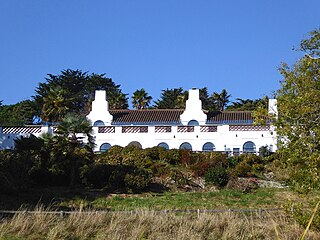
Portland House is a 20th-century detached house, located at Weymouth, Dorset, England. It is found in the area known as Bincleaves, overlooking Portland Harbour. The house, built in 1935, is now in the care of the National Trust, who lets the building as a holiday cottage.

Weymouth Old Town Hall is a former town hall at Weymouth, Dorset, England. The building, which was built with Portland stone in the 1770s, has been Grade II listed since 1953. The bell turret is believed to date from the 17th century. Since 2009, the hall has been operated for community use by the Guardians of the Old Town Hall.



















